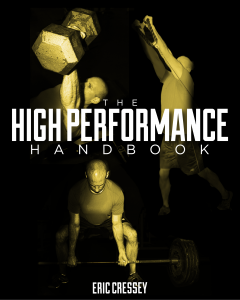
Recency Bias and Long-Term Training Success
Last week, I was reading through a quarterly magazine published by a financial advisory firm with whom my wife and I work, and it introduced the concept of recency bias. WikiInvest.com describes this phenomenon as:
“Recency Bias is where stock market participants evaluate their portfolio performance based on recent results or on their perspective of recent results and make incorrect conclusions that ultimately lead to incorrect decisions about how the stock market behaves.”
In other words, when the stock market tanks, people are – in the short-term – very reluctant to invest. And, when the market thrives, they can’t wait to invest. This is in spite of the fact that these might be the exact opposite of the best approaches, and inherently at odds with a fiscally responsible long-term strategy.

Interestingly, the concept of recency bias has implications in the rehabilitation, health, and human performance fields. To illustrate this, I’ll give you an example.
Back in October of 2015, I had a one-time consult at our Florida facility with a individual with chronic shoulder, elbow, and hip/lower back issues. After a week-long stay in Florida with an assessment and week of in-person coaching, he followed up with online-only programs from across the country. His progress was fantastic in that time, with his exercise pool expanding and movement quality improving significantly. What was especially interesting was seeing the shift from “movement weary” to “fired up to train.”
His first few months of programming was very much about feeling out exercise selection and technique. For example, here were three email excerpts:
November 8: “Missed my first week of workouts after I got back home. Everything has been going good since. I plan on spending some extra weeks on this program before getting a new one to master the techniques on the serratus and periscapular exercises.”
December 7: “.Can you check my wall slide form? Sometimes I feel it a tad bit in the front of the shoulder on the upward rotation and lift off.”
December 16: “Need some help on bottoms up KB crosswalk. Not sure if I have the proper overhead scapula position. and suspect I might be in a bit of extension.”
When it comes to movement quality, I often talk with new clients about an eight-week magic mark. Be consistent for eight weeks, and re-evaluate where you stand. If there isn’t considerable progress, you may need to shake things up with your approach. Take a look at what happened to the tone of the emails in the months that followed:
December 30: “Great new program by the way. I like how you bridged the gap between weights and corrective exercise. Shoulders and elbows feel better.”
April 8: “Hips are feeling better than before I started the program!! Getting better glute activation on the back leg during lunges, and also getting better hip extension on bridges and hip thrusts were both very helpful for the hips.”
May 24: “Keep working on my tight hips. Feeling better there but still a little stiff. My front squat went up! Keep getting stronger, and keep the shoulders safe!”
July 26: “New program is awesome! I didn’t think I would be able to bench pain free before I started. Super psyched to see bench in my program.”
August 28: “New program time! Made some good gains on the last one looking forward to the new one. Hips feel 3 times better. I want to make some more strength gains on this new program. Just throw in enough corrective exercise for all my previous chronic injuries. Really excited for this new program. I’m getting a lot stronger and I feel like a beast again!”
This is where you see how important it is to avoid recency bias in your training, whether you have a considerable injury history or you want to avoid an injury in the first place. This individual is doing a great job of recognizing that while things are going well, he needs to preserve the balance between pushing his body and taking care of it. And, I’m sure that there will be times moving forward when we’ll have to remind him to pump the brakes a bit; it’s the give and take of training progressions.
Don’t only do your correctives when you are a) hurt or b) have recently been hurting; make sure to keep at least some of them around for the long haul. As my physical therapist buddy, Eric Schoenberg, has said,
[bctt tweet=”What gets you healthy keeps you healthy.”]
Likewise, just because you’ve been healthy and managed to get away with brutal training technique and horribly designed programming doesn’t mean that it’ll last forever. As I Tweeted in the past,
Athletes think they’re invincible…until they’re not. It’s important to teach them to be proactive before they ever have to be reactive.
— Eric Cressey (@EricCressey) December 20, 2014
Now, please keep in mind that I’m not advocating that you foam roll for four hours per day and complete a two-a-day, 57-exercise mobility routine. If you’re efficient with your exercise selection and pristine with your training technique, it can be accomplished relatively easily. If you look at the warm-ups in The High Performance Handbook, they cover the overwhelming majority of any “correctives” you’d need, and the rest is accounted for with the comprehensive, well-balanced strength and conditioning programs. It’s not a rehab program; but it could very well be called an “avoid rehab” program.
The take-home point of this article is every successful approach to training avoids the recency bias trap. Just because something happened in the recent past doesn’t necessarily mean it should be more heavily weighted in your planning or execution. In other words, have a smart plan – and stick to it!


